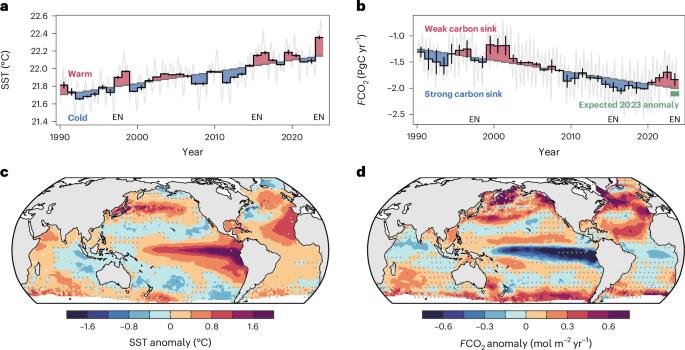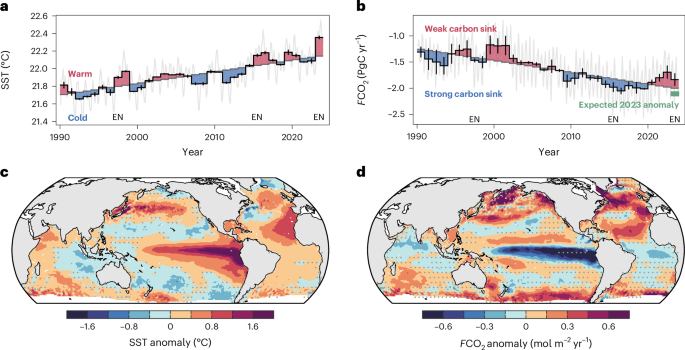在2023年创纪录的海面温度下,海洋碳汇意外下降
IF 27.1
1区 地球科学
Q1 ENVIRONMENTAL SCIENCES
引用次数: 0
摘要
2023年,海面温度(SSTs)达到历史新高,部分原因是强厄尔尼诺Niño。根据对全球平均海温升高的历史响应,2023年海洋二氧化碳吸收量应增加(- 0.11±0.04 PgC /年- 1),这是由于热带太平洋排放减少所致。然而,利用基于观测的海洋CO2逸度估计,我们在这里表明,全球非极地海洋吸收的CO2比预期减少了约10%(+0.17±0.12 PgC yr - 1)。这种减弱是由于亚热带和亚极地地区,特别是北半球的CO2异常脱气造成的,主要是由于海温升高降低了CO2的溶解度。在大多数地区,表层混合层中溶解无机碳的耗竭减轻了海温引起的脱气。这种负反馈导致海洋碳汇对创纪录的海温的总体反应减弱,但在长期变暖或更严重的海温极端情况下,这种恢复能力可能不会持续下去。本文章由计算机程序翻译,如有差异,请以英文原文为准。


Unexpected decline in the ocean carbon sink under record-high sea surface temperatures in 2023
In 2023, sea surface temperatures (SSTs) reached record highs, partly due to a strong El Niño. Based on historical responses to elevated global mean SSTs, oceanic CO2 uptake in 2023 should have increased (−0.11 ± 0.04 PgC yr−1), driven by reduced outgassing in the tropical Pacific Ocean. However, using observation-based estimates of ocean CO2 fugacity, we show here that the global non-polar ocean absorbed about 10% less CO2 than expected (+0.17 ± 0.12 PgC yr−1). This weakening was caused by the anomalous outgassing of CO2 in the subtropical and subpolar regions, especially in the Northern Hemisphere, driven primarily by elevated SSTs reducing the solubility of CO2. In most regions, this SST-induced outgassing was mitigated by the depletion of dissolved inorganic carbon in the surface mixed layer. Such negative feedbacks caused an overall muted response of the ocean carbon sink to the record-high SSTs, but this resilience may not persist under long-term warming or more severe SST extremes. The ocean carbon sink strengthened in previous warm El Niño years due to reduced CO2 outgassing in the tropics. Here the authors show that the ocean carbon sink declined in 2023 despite record-high sea surface temperatures (SSTs), primarily due to SST-driven outgassing of CO2 in the subtropics.
求助全文
通过发布文献求助,成功后即可免费获取论文全文。
去求助
来源期刊

Nature Climate Change
ENVIRONMENTAL SCIENCES-METEOROLOGY & ATMOSPHERIC SCIENCES
CiteScore
40.30
自引率
1.60%
发文量
267
审稿时长
4-8 weeks
期刊介绍:
Nature Climate Change is dedicated to addressing the scientific challenge of understanding Earth's changing climate and its societal implications. As a monthly journal, it publishes significant and cutting-edge research on the nature, causes, and impacts of global climate change, as well as its implications for the economy, policy, and the world at large.
The journal publishes original research spanning the natural and social sciences, synthesizing interdisciplinary research to provide a comprehensive understanding of climate change. It upholds the high standards set by all Nature-branded journals, ensuring top-tier original research through a fair and rigorous review process, broad readership access, high standards of copy editing and production, rapid publication, and independence from academic societies and other vested interests.
Nature Climate Change serves as a platform for discussion among experts, publishing opinion, analysis, and review articles. It also features Research Highlights to highlight important developments in the field and original reporting from renowned science journalists in the form of feature articles.
Topics covered in the journal include adaptation, atmospheric science, ecology, economics, energy, impacts and vulnerability, mitigation, oceanography, policy, sociology, and sustainability, among others.
 求助内容:
求助内容: 应助结果提醒方式:
应助结果提醒方式:


